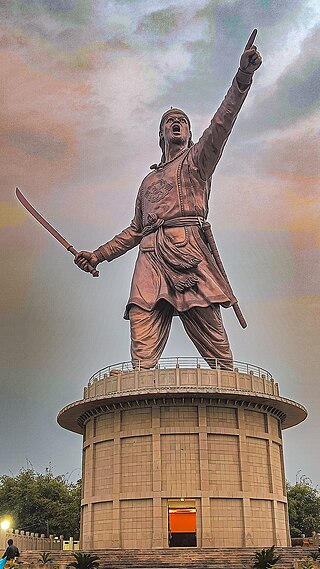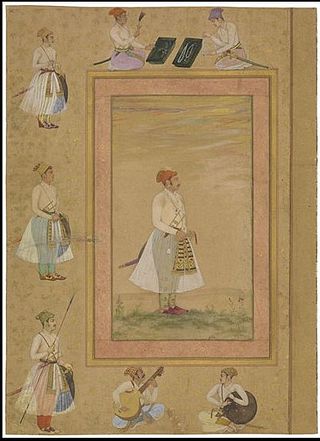
Buranjis are a class of historical chronicles and manuscripts associated with the Ahom kingdom. There were written initially in the Ahom Language and later in the Assamese language as well. The Buranjis are an example of historical literature which is rare in India—they bear resemblance to Southeast Asian traditions of historical literature instead. The Buranjis are generally found in manuscript form, a number of these manuscripts have been compiled and published especially in the Assamese language.

Lachit Borphukan was an Ahom Borphukan, primarily known for commanding the Ahom Army and the victory in the Battle of Saraighat (1671) that thwarted an invasion by the vastly superior Mughal Forces under the command of Ramsingh I. He died about a year later in April 1672.

The Battle of Saraighat was a naval battle fought in 1671 between the Mughal Empire, and the Ahom Kingdom on the Brahmaputra river at Saraighat, now in Guwahati, Assam, India. This was the decisive battle that ended the years long Mughal siege of Guwahati, with the Ahoms pushing away the Mughals west beyond the Manas river.

The history of Assam is the history of a confluence of people from the east, west, south and the north; the confluence of the Austroasiatic, Tibeto-Burman (Sino-Tibetan), Tai and Indo-Aryan cultures. Although invaded over the centuries, it was never a vassal or a colony to an external power until the third Burmese invasion in 1821, and, subsequently, the British ingress into Assam in 1824 during the First Anglo-Burmese War.

Koch Hajo (1581–1616) was the kingdom under Raghudev and his son Parikshit Narayan of the Koch dynasty that stretched from Sankosh River in the west to the Bhareli River in the east on the north bank of the Brahmaputra River. It was created by dividing the Kamata kingdom then under Nara Narayan in medieval Assam. The Sankosh River divided the two new kingdoms, and it is roughly the boundary between the present-day Assam and West Bengal. The western half of the Kamata kingdom emerged as Koch Bihar whereas the eastern half emerged as Koch Hajo. The name Hajo comes from the legendary king Hajo, a Koch tribal chief and an ancestor of the Koch dynasty, who ruled over the Rangpur division in present-day Bangladesh and some regions of present-day Assam.

The Treaty of Ghilajharighat, Tipam, was signed between the Ahoms and the Mughal forces led by Mir Jumla II on January 23, 1663. The treaty Mir Jumla II brought occupation of the Ahom capital, Garhgaon, to an end.

Mirza Raja Ram Singh I was the Raja of the Kingdom of Amber and head of the Kachwaha Rajput clan, succeeding his father Mirza Raja Jai Singh I. He also served as the general of the Mughal Empire and commander-in-chief of its army as well as the Subahdar of Kashmir.

Ahom–Mughal wars refers to the series of 17th-century conflicts between the Ahoms and the Mughals over the control of the Brahmaputra valley. It began soon after the eastern branch of the Kamata kingdom then under the Koch dynasty, Koch Hajo, collapsed after a sustained Mughal campaign bringing it face-to-face with the eastern Ahoms. After nearly seventy years of sustained efforts, the Mughals were finally ousted in the Battle of Itakhuli in 1682. The Mughals since then maintained interest to the region west of the Manas river via zamindars, till they were ousted from Bengal by the British about a hundred years later.

Supangmung, also known as Chakradhwaj Singha, was an important Ahom king under whom the Ahom kingdom took back Guwahati from the Mughals following the reverses at the hands of Mir Jumla and the Treaty of Ghilajharighat. He is known for his fierce pride as an Ahom monarch.
The Assamese people are a socio-ethnic linguistic identity that has been described at various times as nationalistic or micro-nationalistic. This group is often associated with the Assamese language, the easternmost Indo-Aryan language, and Assamese people mostly live in the Brahmaputra Valley region of Assam, where they are native and constitute around 56% of the Valley's population. The use of the term precedes the name of the language or the people. It has also been used retrospectively to the people of Assam before the term "Assamese" came into use. They are an ethnically diverse group formed after centuries of assimilation of Austroasiatic, Tibeto-Burman, Indo-Aryan and Tai populations, and constitute a tribal-caste continuum—though not all Assamese people are Hindus and ethnic Assamese Muslims numbering around 42 lakh (4,200,000) constitute a significant part of this identity. The total population of Assamese speakers in Assam is nearly 15.09 million which makes up 48.38% of the population of state according to the Language census of 2011.

Mir Jumla II, or Amir Jumla, also known as Ardistānī Mir Muhammad, was a military general, wealthy diamond trader, a Vizier of Golconda sultanate, and later a prominent subahdar of Bengal under the Mughal Emperor Aurangzeb.
Munnawar Khan was a Mughal Empire admiral during the reign of Emperor Aurangzeb.

Mir Jumla II invaded the Ahom kingdom in January 1662 and left it in January–February 1663. He was able to occupy Garhgaon, the Ahom capital, before the beginning of the rainy season, but he and his army were confined mostly to Garhgaon and Madhupur during that period. The Ahom king Sutamla had to take flight and hide in Namrup during Mir Jumla's occupation of the capital. The defection of Baduli Phukan, a high ranking Ahom commander, precipitated the Treaty of Ghilajharighat in January 1663, with the Ahom king accepting tributary status. Mir Jumla died on his way back before he could reach Dhaka, his capital.

Kamrup is the modern region situated between two rivers, the Manas and the Barnadi in Western Assam, with the same territorial extent as the Colonial and post-Colonial "Undivided Kamrup district". It was the capital region of two of the three dynasties of Kamarupa and Guwahati, the current political center of Assam, is situated here. It is characterized by its cultural artifacts.

The Battle of Itakhuli was fought in August 1682 between the Ahom Kingdom and the Mughal Empire. The Ahoms pushed back Mughal control to the west of the Manas River. The main battle was fought at a garrison island on the Brahmaputra, in which the Mughal fauzdar, Mansur Khan, was defeated and the remnant of the Mughal forces pursued to the Manas River. With this win, the Ahoms recovered Sarkar Kamrup from the Mughals.

The Undivided Goalpara district is an erstwhile district of Assam, India, first constituted by the British rulers of Colonial Assam.
Ramani Gabharu was a princess of Kingdom of Assam and the first wife of titular Mughal emperor Muhammad Azam Shah. She was sent to the Mughal Emperor as part of the Treaty of Ghilajharighat at the age of seven and was renamed Rahmat Banu Begum after she married Muhammad Azam Shah.
The Ahom Army consisted of cavalry, infantry as well as naval units based on the Paik system militia of the Ahom kingdom (1228–1824). The kingdom did not have standing army units of professional soldiers till late 18th and early 19th centuries, when Purnandan Burhagohain raised one after noticing the effectiveness of Captain Thomas Welsh's sepoys in subjugating the Moamoria rebellion.

The Battle of Alaboi was fought between the Ahom Kingdom and the Mughal Empire around 5 August 1669. The result was a Mughal victory, but Ram Singh I's next move was to open negotiations for peace. The Assamese also were tired of war, and hostilities were suspended for a time. Soon after the battle of Alaboi, Chakradhwaj Singha died in 1669. He was succeeded by his brother Udayaditya Singha. This was part of the seizure of Guwahati that led up to the final Battle of Saraighat which the Ahoms won.

The Battle of Kaliabor, also known as Battle of Kaliabar, marked a pivotal naval military confrontation between the Mughal Empire, under the command of its general Mir Jumla II, and the Ahom dynasty, led by Bargohain, on March 3, 1662, near the location known as Kaliabor, situated in modern-day Assam.









